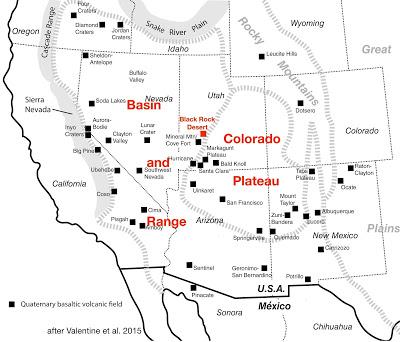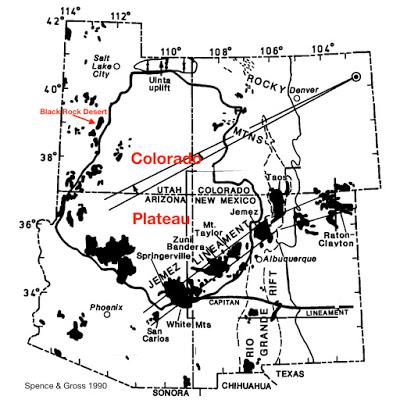
Black Rock Desert volcanic field in western Utah.
Volcanic eruptions have been big news lately, with graphic accounts from Hawaii, Bali and Guatemala, and fearsome stories of much greater destruction not so long ago. Yet most of us consider volcanism no threat to us personally. And we’re right. In the greater scheme of things, volcanoes are rare.
A volcano won’t erupt in your cornfield unless you farm in just the right place (Paricutín 1943).
Volcanoes are born when magma forces its way to the surface and becomes red-hot oozing lava, or a fiery fountain of ash and fractured rock, or a racing incandescent cloud that hugs the ground and incinerates everything in its path. But magmas don’t form just anywhere. They—and therefore volcanoes—require special circumstances.
Magma was once thought to flow from Hell, e.g. via Iceland’s Mount Hekla, the Gateway to Hell (source).
Magma is liquid rock, specifically silicate rocks (rich in SiO2). Therefore none of the layers of the Earth qualifies as a direct source of magma. Crust and mantle have the proper composition but are solid. The outer core is liquid, but the composition is wrong—iron and nickel. Therefore magmas must be melted mantle and crust (1). But what is the source of heat for melting? It’s here that debates rage.
Earth’s structure can be described by physical properties or by chemical composition; see (2). For this post, only “mantle” and “crust” are used, as is common in less technical discussions. Modified from Nelson 2015.

Global distribution of volcanoes coincides with certain types of plate boundaries (USGS via wikimedia).
A world map of active volcanoes reveals a suggestive pattern. Most line up along plate boundaries—where the shifting plates that make up the Earth’s surface collide, override, jostle and split in the dance of plate tectonics. This is an appealing pattern because several types of plate interactions could facilitate melting to form magma. Decompression melting probably occurs at divergent boundaries such as mid-oceanic ridges and rift valleys. At convergent boundaries (subduction zones), addition of water could lead to flux melting (Nelson 2015; OSU Volcano World). But not all volcanoes conform to the pattern. Some erupt far from any plate boundary, and these intraplate volcanoes are difficult to explain. Above and below, Ice Springs basalt flow in the Black Rock Desert, the most recent volcanic eruption in Utah. But why here?
Above and below, Ice Springs basalt flow in the Black Rock Desert, the most recent volcanic eruption in Utah. But why here?

Looks fresh enough to have erupted last year!
The Black Rock Desert volcanic field (3) is located about 120 miles south of Salt Lake City, Utah, well into the interior of the North American plate. It covers almost 2700 sq mi (7000 sq km), and includes shield volcanoes, cinder cones, lava domes, lava flows, maars and possibly a caldera. All are Quaternary in age, having erupted in the last 6 million years—most in the last 2.7 million. In other words, this field is young—and may still be active.The field sits at the eastern edge of the Basin and Range Province, just west of the Colorado Plateau. Herein may lie an explanation for the intraplate volcanism. Though far from a plate boundary, this part of North America is hardly stable. Big changes are underway.
Quaternary volcanic fields are common in the Basin and Range Province and on the margins of the Colorado Plateau; modified from Valentine et al. 2017.
West of the Black Rock Desert, the Basin and Range Province has been expanding east-west for the last 30 million years, increasing the distance to the West Coast by 250 miles. Crustal extension may explain, at least in part, the Province’s thin crust; the mantle (asthenosphere) is only about 17-18 miles below the surface. And crustal thinning may explain (partly) the many Quaternary volcanic fields (map above).Just east of the Black Rock Desert is the Colorado Plateau, which is very different from the Basin and Range Province. It’s a big chunk of crust that is thick (25-30 miles) and relatively undeformed. Volcanism is mostly restricted to the margins. Yet the Plateau is changing too. Precise GPS measurements show it's slowly rotating clockwise (4).Most intriguing is the boundary between the extending Basin and Range Province and the rotating Colorado Plateau (5). It just happens to be lined with Quaternary volcanic fields, including the Black Rock Desert! Surely there’s a story here!!
Note volcanism along Colorado Plateau margins (Spence & Gross 1990).
In fact, there are multiple stories, all based to some degree on speculation. The earliest invoked a rising plume of hot mantle material over which the continent drifted, producing a line of progressively younger volcanism. While a “hotspot” model works well in Hawaii, it would be awkward to apply to the Colorado Plateau, requiring multiple hotspots and/or varied direction of movement.But there may be no need to invoke mantle plumes; plate dynamics may be enough (6). Rotation and/or extension could be fracturing the crust sufficiently to create conduits for magma, especially where the crust is thinner (DeCorten 2003; see also Recent Volcanic Activity in Northern Arizona which includes discussion of western Utah). Or perhaps magma is rising through fractures in reactivated ancient crustal sutures (see my Jemez Lineament post). Ballmer et al. (2015) suggest that the difference in thickness between Basin and Range crust and that of the Colorado Plateau may affect mantle flow and cause decompression melting.
Looking north from Tabernacle Hill across basalt flows toward Pavant Butte, a large tuff cone.
Whatever the cause of magma generation, it seems likely that Black Rock Desert volcanism will continue. Little if anything has changed since the last eruptions, just 700 years ago. Basin and Range crust is still stretching, the Colorado Plateau is still rotating, and local mantle flow likely hasn’t changed much.“There is really no more reason to believe that the epoch of basalt has closed in this region, than that it has barely begun; and it is certainly probable that the few centuries we can know by history and tradition, belong to one of the intervals of quiet, such as separate the more or less convulsive efforts of volcanoes; an interval to be terminated sooner or later by a renewal of activity.” Grove Karl Gilbert, 1875

Pavant Butte, from GK Gilbert’s 1890 Lake Bonneville monograph (USGS).

“Lava from valley of lower Sevier Utah” (Black Rock Desert; Gilbert 1875).
Utah’s Black Rock Desert lies just west of Interstate Highway 15 near Fillmore. Geo-tripping is convenient and fun. Most sites are on public land, and accessible by gravel and passable dirt roads. A wealth of geo-info makes the area especially interesting, ranging from the excellent Millard Country travel brochure to the scientific literature. In May I spent a week there, which wasn't nearly enough. More posts from the trip will be up soon.

"Volcanic District near Fillmore, Utah" (Gilbert 1890).
Notes(1) Properly speaking, magma forms from partial melts—of mantle rock most often and occasionally crust.(2) Two systems are used to describe Earth structure: physical properties and chemical composition. The resulting units are not equivalent. For example, based on physical properties, the outermost layer—the lithosphere—is solid brittle rock. But the lithosphere includes two different rock types based on chemistry—crust and uppermost mantle. Another example: the mantle is thought to be uniform chemically, but has three zones based on physical properties: the solid brittle part in the lithosphere, a solid but ductile asthenosphere directly below, and the solid mesosphere (source).(3) This is not the Burning-Man Black Rock Desert of northwest Nevada.(4) Estimated rotation rate for the main body of the Colorado Plateau is 0.103 ± 0.017° per Ma. Rates at the margins appear to be affected by Basin and Range extension (Kreemer et al. 2010).(5) The western margin of the Colorado Plateau is sometimes called the Basin & Range Colorado Plateau Transition Zone (map courtesy Utah Geologic Survey).
 (6) For more about the raging plume-ist vs. plate-ist debate, see Jack Share’s The Geologic Evolution of Iceland—specifically “A NEW GEOLOGICAL PARADIGM” about 2/3 of the way through the post.
(6) For more about the raging plume-ist vs. plate-ist debate, see Jack Share’s The Geologic Evolution of Iceland—specifically “A NEW GEOLOGICAL PARADIGM” about 2/3 of the way through the post.Ballmer, MD, et al. 2015. Intraplate volcanism at the edges of the Colorado Plateau sustained by a combination of triggered edge-driven convection and shear-driven upwelling. Geochem. Geophys. Geosyst., 16: 366–379. doi:10.1002/ 2014GC005641.DeCourten, FL. 2003.The Broken Land: adventures in Great Basin geology.Salt Lake City, Utah: University of Utah Press.
Gilbert, GK. 1875. Report upon the geology of portions of Nevada, Utah, California, and Arizona, examined in the years 1871 and 1872, in Wheeler, GM, Report upon United States geographical surveys west of the one hundredth meridian, v. 3, Washington DC:GPO. https://www.biodiversitylibrary.org/bibliography/49058
Gilbert, GK. 1890. Lake Bonneville. USGS Monograph 1. Washington DC:GPO. https://pubs.er.usgs.gov/publication/m1
Johnsen, RL, et al. 2010. Subalkaline volcanism in the Black Rock Desert and Markagunt Plateau volcanic fields, in Carney, SM, et al., eds., Geology of south-central Utah. Utah Geological Association Publication 39.
Kreemer, C, et al. 2010. Present‐day motion and deformation of the Colorado Plateau. Geophys. Res. Letters 37: L10311. doi:10.1029/2010GL043374
Nelson, SA. 2015. Structure of the Earth and the origin of magmas. Tulane University EENS 2120 Petrology (online lecture notes).
Spence, W, and Gross, RS. 1990. A tomographic glimpse of the upper mantle source of magmas of the Jemez Lineament, New Mexico. Journal of Geophysical Research 95 B7:10,829-10,849.
Valentine, GA, et al. 2017. Lunar Crater volcanic field (Reveille and Pancake Ranges, Basin and Range Province, Nevada, USA) Geosphere13: 391-438. https://doi.org/10.1130/GES01428.Volcano Hotspot. 2018-01-09. Recent volcanic activity in SW Utah.
